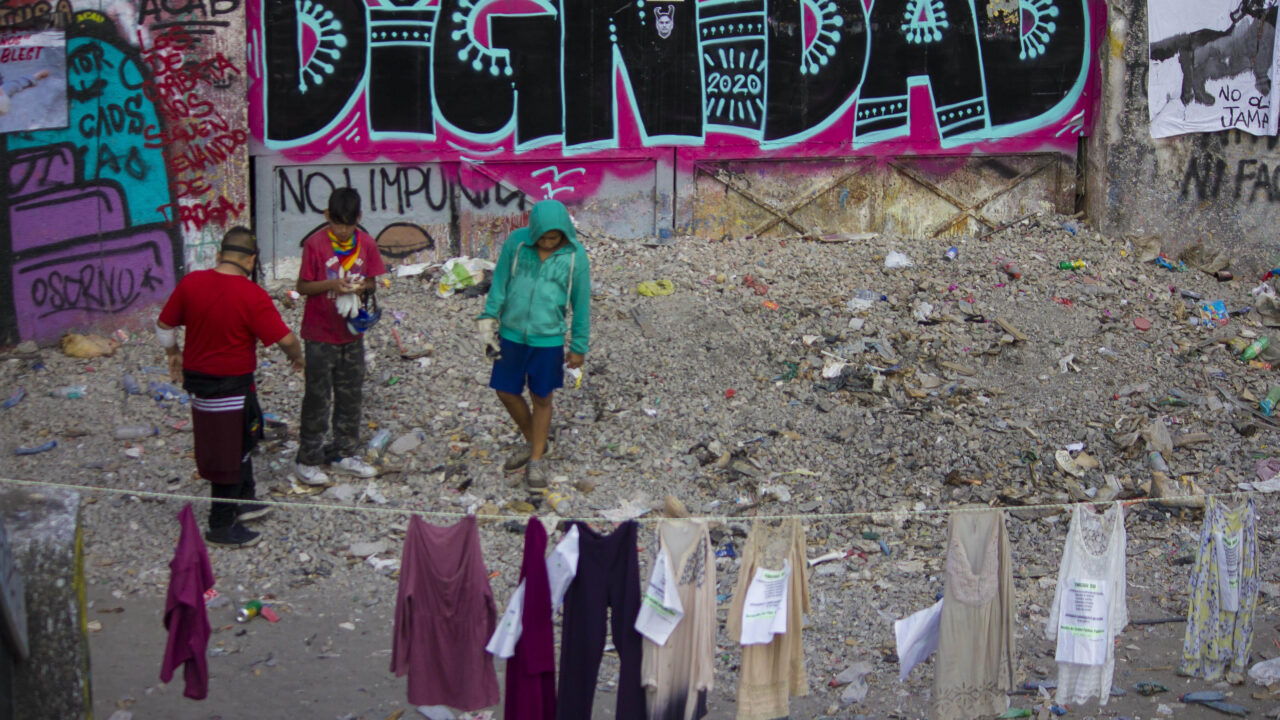The failure of the proposed Chilean constitution marks a turning point in the process that began with the 2019 social uprising in Chile. On the one hand, President Boric is committed to ensuring the creation of a new constitutional process, making it clear that the constitution of the Pinochet dictatorship must be put to rest. On the other hand, the new political realities will be difficult to navigate: a government with a leftist program, two legislative chambers with conservative majorities, and a people whose capacity for mobilization and protest has been significantly diminished by the COVID-19 pandemic, inflation, and worsening conditions.
While the results of the plebiscite feel devastating, we have an opportunity to learn from them. In her book, To Move a Mountain: Fighting the Global Economy in Appalachia, Eve Weinbaum makes a case for “successful failures.” She argues that even when campaigns fail, sometimes they can lay the groundwork for bigger and better change. It’s useful to see the 2019 social uprising and subsequent constitutional process through this framework. Not all is lost; far from it. The last three years have activated and mobilized millions of people in Chile. They have brought marginalized people into the political process and forced a reckoning with neoliberalism. It’s too soon to tell what will come next, but we know from history that activated people do not just disappear into the shadows.
We’ve divided this article into three parts. First, we discuss a brief history of the constitutional process; next, we turn to what would have been the contributions of the new constitution to the labor movement, indigenous peoples, the environment, women, and the LGBTQ+ community; finally, we reflect on what US organizers and activists can learn from the constitutional convention process in Chile.
Brief History of the Constitutional Process
On October 18 and 19, 2019, the successive episodes of unrest that began in Santiago de Chile turned into an uprising involving millions of protesters throughout the country. Despite its origin — a thirty peso (four cents in USD) increase in the cost of public transport in the capital — the massification of the protest diversified its demands: salaries, pensions, health care, and a long list of grievances stemming from the social consequences of neoliberalism (an inheritance entrenched by the democratic governments that succeeded the Pinochet regime). This is why the most commonly repeated slogan became, “It wasn’t 30 pesos; it was 30 years.”
The government reaction was quantified in the thousands of people wounded, hundreds mutilated, and dozens killed by the actions of the police and military forces, under the orders of a president who on October 20 declared war on the protesters on live television. Far from stopping the protests, this repression only brought more people into the streets, radicalized the response, and consolidated solidarity. This popular response led to desperate objections and criticisms by the right wing and business sector.
For example, Luis Larraín Arroyo, former minister of the Office of National Planification under dictator Augusto Pinochet, offered the following in an opinion piece for El Libero:
On several occasions, [the Labor Union bloc] has called for mobilizations that have coincided with the days of greatest violence (…) The dynamics of these days have been similar. The calls have failed in their attempt to paralyze activities, [but] around sunset, violent demonstrations begin in various cities across the country, including looting, barricades, attacks on police headquarters, and destruction of public and private property.
Sebastián Osorio and Diego Velásquez argue that the most critical of these days was the general strike of November 12. The strike was the turning point in creating the possibility for a constitutional process because it illustrated that the mass movement was not going away and that the labor movement had joined other social movement forces in pressuring the government to act. Indeed, this action led to the creation of the “Agreement for Peace and a New Constitution” — drafted at dawn on November 15 and signed by practically all political parties, with the exception of the Communist Party and Convergencia Social (“Social Convergence,” the party of then-deputy Gabriel Boric).
The Agreement provided for a two-question voluntary vote on October 25, 2020. Citizens had to either “approve” or “reject” the drafting of a new constitution and also decide whether all the drafters should be elected — a “Constitutional Convention” — or if half of them should be Congressional representatives already in office — a “Mixed Convention.” Seventy-eight percent of voters approved the drafting of a new constitution, with 79% voting for a constitutional convention. This involved choosing 155 constituent delegates, under a gender parity system, who were elected by nearly 6.5 million people on May 15 and 16, 2021. Politically, the election of the delegates revealed two important facts: the crisis of the traditional parties (independents obtained one-third of all seats, 64% counting non-militants running on party lists) and the isolation of the right wing, which won only 37 seats and even lost its veto capacity (established at one-third).
This Convention began on July 4, 2021, and ten days later approved its first three commissions — budget, regulations, and ethics — later adding another five: human rights, communications, indigenous participation and consultation, decentralization, and popular participation. The latter established that citizens could present constitutional norms for discussion. On October 18, the constitutional debate began with the implementation of seven thematic commissions: political system, form of the state, constitutional principles, fundamental rights, environment, justice system, and knowledge systems.
One month later — on November 21 — the first round of the Chilean presidential election was held; the far-right candidate José Antonio Kast came in first, with 27% of the vote. This might seem surprising, given the landslide and unprecedented vote in the plebiscite; however, it can at least partially be explained by the right’s mobilization and fear-mongering during the election as well as Chilean citizens’ disillusionment with all of the political parties. Voter turnout was significantly lower than in the plebiscite, which captured the imagination and energy of young people. Still, Deputy Gabriel Boric — representing the Frente Amplio (“Broad Front”) and the Communist Party — obtained 25% of the vote. In the runoff election, Boric managed to reverse this result, obtaining 55% (4,620,890 votes) to Kast’s 45% (3,650,088). This made Boric one of the most voted president-elects in the history of the country, as well as the youngest.
In terms of the constitutional process, on February 2, 2022, the deadline for presenting regulatory initiatives and for popular initiatives to gather the fifteen thousand signatures required to be discussed expired. On May 9, the last three commissions were established: harmonization, provisional rules, and preamble; voting on the permanent rules ended on May 14. Finally, on June 28, the harmonization proposal was voted on, and on July 4, the final draft, consisting of 388 articles and 57 provisional regulations, was submitted to President Gabriel Boric.
At the September 4th plebiscite, 62% of voters rejected the proposed constitution, dealing a blow to the left and many social movements. Despite this tragic loss, it continues to be worthwhile to study the proposed constitution, as it was a pathbreaking document, not only for Chile but for social movements globally.
What would have been the main advances had the Constitution passed?
The 1980 constitution was created during Pinochet’s dictatorship (1973-1990); its main legacies are the most serious human rights violations the country has ever seen — with hundreds of thousands of people imprisoned, tortured, executed, and disappeared — and the early implementation of (and legal framework for) the neoliberal project. In addition to having been written behind closed doors and legitimized through fraud, this constitution established a series of clauses that prevented its democratic reform — including a bipartisan political system with practically unattainable quorums — and assigned the state a subsidiary role with respect to private companies, even in the sphere of basic necessities.
The proposed constitution, on the other hand, opposed secrecy and embraced transparency, beginning with its first five words: “Chile is a social State.” Its entire content was a response to the disastrous consequences of the neoliberal project over the last forty years, especially in terms of inequality. Due to the number of articles and subsections, however, we will only discuss the content of four areas that we believe are of utmost importance: everything referring to the power of workers, indigenous peoples, the environment, women, and the LGBTQ+ community.
In the field of labor and work, the main advances would have been in union rights, due to their potential impact on power relations relative to capital. Article 47 began by recognizing the right to freedom of association, including the right to unionization, collective bargaining, and strikes. But it also would have given unions exclusive entitlement to collective bargaining rights (preventing the action of “negotiating groups,” groups of non-unionized workers making deals with management) and allowed them to choose at which level bargaining would occur — including branch, sectoral, and territorial — and to determine the reasons a strike may be called without legal limitations. In the previous constitution, the word “strike” appeared only once and in a negative sense — that is, to prohibit it.
With regard to indigenous peoples, the first paragraph established the plurinational character of the state and, consequently, other articles enshrined the autonomy, self-determination, and self-government of indigenous peoples and nations. This included their lands, territories, and resources and would have represented a radical democratic advance. There still remains much work to do in terms of indigenous rights, and indigenous communities had a mixed political perspective on what the constitution would have offered, but most would agree it would have been an advance.
Fifty regulations referred directly or indirectly to environmental protections, including new subjects of rights, such as nature and animals. These included articles that protected nature from privatization and climate change and that forced the state to provide adequate education on the environment. The constitution also created new regulating institutions, such as the Ombudsman for Nature and the National Water Agency. In fact, water would have been consigned as a fundamental right; the text also established that it is “inappropriable” (unable to be privately owned) and must be used sustainably “for present and future generations.” The text further recognized and protected “the traditional use of waters located in indigenous territories.” This would have been particularly consequential because the Chilean economy has relied on forestry and mining extractivism, which are water-intensive industries and ones often located in indigenous territories.
With regard to the rights of women and the LGBTQ+ community, it is important to note that the entire constitutional text centered gender parity. For example, Article 1 established gender parity as a central characteristic of democracy. Although sexual and reproductive rights — particularly abortion — have drawn the most attention due to conservative backlash, there were other significant rights expressed in the constitution, including advances in terms of the recognition of domestic and care work, measures to ensure the right to a life free of gender violence, and comprehensive sexual education.
More than anything, the rejected constitution clearly articulated a set of values that dramatically departed from the dictatorship-era constitution. Some of these values were clearer and better articulated than others, which would have created challenges on the road to legislative implementation. The vagueness of certain positions — such as giving rights to nature — might also have played a role in the vote to reject the proposed constitution because it allowed the right to fill in the gaps with lies and misinformation.
Reflections and Lessons for US Organizers and Activists
In the United States, it is difficult to imagine building a social movement so powerful that it opens the door to a constitutional process. The 2019 uprising in Chile may have appeared to be quite spontaneous, somewhat similar to other movements such as Occupy Wall Street, Indignados, the Arab Spring, or even Black Lives Matter. Like those movements, however, the Chilean uprising was not entirely spontaneous. As we have already stated, it was a response to thirty years of neoliberal policy — and it resulted from the organization and mobilization of student, feminist, indigenous, environmental, and union movements in recent decades, which created the political crisis that opened the doors for a constituent process.
Yet for some on the left, the constitutional process was inherently a reformist project negotiated by political parties. For them, the 2019 uprising represented a revolutionary moment in which they could have won the expulsion of President Sebastian Piñera and a constituent assembly (similar to the one Venezuela had). Others felt excluded from the process and had little trust in the possibility of change. Without a doubt, the right rejected the process from the beginning.
Although there were valid criticisms of the constitutional process, the rejected constitution would have been a tremendous step forward from the constitution of the dictatorship. In all likelihood, it would have been far more progressive than whatever constitutional process follows its rejection.
A month after the plebiscite, Chileans continue to debate why the proposed text was rejected. While there are a variety of viewpoints on the reasons (some of which you will see in other articles in this issue) there are some points of agreement. First and foremost is the brutal campaign of misinformation on the contents of the constitution that was led by the right and economic elite. Second, Chileans genuinely rejected the comportment of some of the convention delegates and certain aspects of the text that invoked uncertainty (such as the implications of plurinationality or control over pension funds). Third, the plebiscite served as a proxy to disapprove of Boric’s leadership in the first six months of his presidency. Issues such as inflation, crime, and the lack of political experience of some of his ministers featured prominently. The huge margin by which voters rejected the constitution can be explained by the imposition of a mandatory vote, which was not a requirement of any of the other elections related to the constitutional process. The numbers illustrate that this requirement favored the rejection campaign. In this context, the right and political center have regained the footing that they had lost in 2019 and have promoted an “anti-extremist” discourse, which leaves the continuation of the constitutional process up in the air.
The new rhetoric presents an enormous challenge for grassroots power and left political parties. But the experience we have gained and the shift in narrative that we achieved at the height of the constitutional process are a great step forward in the construction of a more unified left project.


